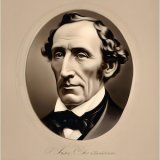The Bottle Neck Page #2
"The Bottle Neck" is a short story by Hans Christian Andersen that details the lifetime adventures of a bottle. Beginning its life as a container of wine, the bottle experiences many incarnations: a buoy at sea, a bird’s home, a corner decoration in a poor man's room. Its life ends trapped in a mason’s wall, only to be discovered years later with a message that carries a lot of significance for its finder. This story is a reflection on life's journey and the significance of past experiences.
Genre: Children
Genre: Children
- 21 Views
was brought forth it appeared as if something pleasant had happened, for every one was laughing; the furrier's daughter laughed too, but she said very little, and her cheeks were like two roses. Then her father took the bottle and the cork-screw into his hands. What a strange sensation it was to have the cork drawn for the first time! The bottle could never after that forget the performance of that moment; indeed there was quite a convulsion within him as the cork flew out, and a gurgling sound as the wine was poured forth into the glasses. "Long life to the betrothed," cried the papa, and every glass was emptied to the dregs, while the young sailor kissed his beautiful bride. "Happiness and blessing to you both," said the old people-father and mother, and the young man filled the glasses again. "Safe return, and a wedding this day next year," he cried; and when the glasses were empty he took the bottle, raised it on high, and said, "Thou hast been present here on the happiest day of my life; thou shalt never be used by others!" So saying, he hurled it high in the air. The furrier's daughter thought she should never see it again, but she was mistaken. It fell among the rushes on the borders of a little woodland lake. The bottle neck remembered well how long it lay there unseen. "I gave them wine, and they gave me muddy water," he had said to himself, "but I suppose it was all well meant." He could no longer see the betrothed couple, nor the cheerful old people; but for a long time he could hear them rejoicing and singing. At length there came by two peasant boys, who peeped in among the reeds and spied out the bottle. Then they took it up and carried it home with them, so that once more it was provided for. At home in their wooden cottage these boys had an elder brother, a sailor, who was about to start on a long voyage. He had been there the day before to say farewell, and his mother was now very busy packing up various things for him to take with him on his voyage. In the evening his father was going to carry the parcel to the town to see his son once more, and take him a farewell greeting from his mother. A small bottle had already been filled with herb tea, mixed with brandy, and wrapped in a parcel; but when the boys came in they brought with them a larger and stronger bottle, which they had found. This bottle would hold so much more than the little one, and they all said the brandy would be so good for complaints of the stomach, especially as it was mixed with medical herbs. The liquid which they now poured into the bottle was not like the red wine with which it had once been filled; these were bitter drops, but they are of great use sometimes-for the stomach. The new large bottle was to go, not the little one: so the bottle once more started on its travels. It was taken on board (for Peter Jensen was one of the crew) the very same ship in which the young mate was to sail. But the mate did not see the bottle: indeed, if he had he
Translation
Translate and read this book in other languages:
Select another language:
- - Select -
- 简体中文 (Chinese - Simplified)
- 繁體中文 (Chinese - Traditional)
- Español (Spanish)
- Esperanto (Esperanto)
- 日本語 (Japanese)
- Português (Portuguese)
- Deutsch (German)
- العربية (Arabic)
- Français (French)
- Русский (Russian)
- ಕನ್ನಡ (Kannada)
- 한국어 (Korean)
- עברית (Hebrew)
- Gaeilge (Irish)
- Українська (Ukrainian)
- اردو (Urdu)
- Magyar (Hungarian)
- मानक हिन्दी (Hindi)
- Indonesia (Indonesian)
- Italiano (Italian)
- தமிழ் (Tamil)
- Türkçe (Turkish)
- తెలుగు (Telugu)
- ภาษาไทย (Thai)
- Tiếng Việt (Vietnamese)
- Čeština (Czech)
- Polski (Polish)
- Bahasa Indonesia (Indonesian)
- Românește (Romanian)
- Nederlands (Dutch)
- Ελληνικά (Greek)
- Latinum (Latin)
- Svenska (Swedish)
- Dansk (Danish)
- Suomi (Finnish)
- فارسی (Persian)
- ייִדיש (Yiddish)
- հայերեն (Armenian)
- Norsk (Norwegian)
- English (English)
Citation
Use the citation below to add this book to your bibliography:
Style:MLAChicagoAPA
"The Bottle Neck Books." Literature.com. STANDS4 LLC, 2024. Web. 21 May 2024. <https://www.literature.com/book/the_bottle_neck_2147>.




Discuss this The Bottle Neck book with the community:
Report Comment
We're doing our best to make sure our content is useful, accurate and safe.
If by any chance you spot an inappropriate comment while navigating through our website please use this form to let us know, and we'll take care of it shortly.
Attachment
You need to be logged in to favorite.
Log In